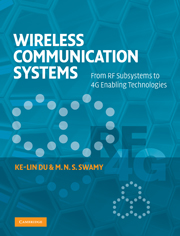Book contents
- Frontmatter
- Contents
- Preface
- Abbreviations
- 1 Introduction
- 2 An overview of wireless communications
- 3 Channel and propagation
- 4 Cellular and multiple-user systems
- 5 Diversity
- 6 Channel estimation and equalization
- 7 Modulation and detection
- 8 Spread spectrum communications
- 9 Orthogonal frequency division multiplexing
- 10 Antennas
- 11 RF and microwave subsystems
- 12 A/D and D/A conversions
- 13 Signals and signal processing
- 14 Fundamentals of information theory
- 15 Channel coding
- 16 Source coding I: speech and audio coding
- 17 Source coding II: image and video coding
- 18 Multiple antennas: smart antenna systems
- 19 Multiple antennas: MIMO systems
- 20 Ultra wideband communications
- 21 Cognitive radios
- 22 Wireless ad hoc and sensor networks
- Appendix A The Q-function
- Appendix B Wirtinger calculus
- Index
20 - Ultra wideband communications
Published online by Cambridge University Press: 05 June 2012
- Frontmatter
- Contents
- Preface
- Abbreviations
- 1 Introduction
- 2 An overview of wireless communications
- 3 Channel and propagation
- 4 Cellular and multiple-user systems
- 5 Diversity
- 6 Channel estimation and equalization
- 7 Modulation and detection
- 8 Spread spectrum communications
- 9 Orthogonal frequency division multiplexing
- 10 Antennas
- 11 RF and microwave subsystems
- 12 A/D and D/A conversions
- 13 Signals and signal processing
- 14 Fundamentals of information theory
- 15 Channel coding
- 16 Source coding I: speech and audio coding
- 17 Source coding II: image and video coding
- 18 Multiple antennas: smart antenna systems
- 19 Multiple antennas: MIMO systems
- 20 Ultra wideband communications
- 21 Cognitive radios
- 22 Wireless ad hoc and sensor networks
- Appendix A The Q-function
- Appendix B Wirtinger calculus
- Index
Summary
Introduction
UWB technology, also known as impulse radio, was first used to transmit Morse codes by Marconi in 1900 through the transatlantic telegraph. Modern UWB technology has been used for radar and communications since the 1960s. Like CDMA systems, early UWB systems were designed for military covert radar and communications. The early applications of UWB technology were primarily related to radar, driven by the fine-ranging resolution that comes with large bandwidth. UWB technology for wireless communications was pioneered by Scholtz. With the intent of operating UWB in an unlicensed mode that overlaps licensed bands, the FCC issued rules under the FCC Rules and Regulations Part 15 for UWB operation in February 2002.
The FCC defined a UWB transmitter as “an intentional radiator that, at any point in time, has a fractional bandwidth equal to or greater than 0.20, or has a UWB bandwidth equal to or greater than 500 MHz, regardless of the fractional bandwidth”. “The UWB bandwidth is the frequency band bounded by the points that are 10 dB below the highest radiated emission, as based on the complete transmission system including the antenna.”
According to the FCC regulations, the transmitter sends pulses with a bandwidth of at least 500 MHz that is within the band 3.1 to 10.6 GHz, for output power densities below −41.25 dBm/MHz. The FCC Part 15 limit of 500 µV/m at 3 meters is equivalent to an effective isotropic radiated power (EIRP) of −41.25 dBm/MHz.
- Type
- Chapter
- Information
- Wireless Communication SystemsFrom RF Subsystems to 4G Enabling Technologies, pp. 870 - 897Publisher: Cambridge University PressPrint publication year: 2010



